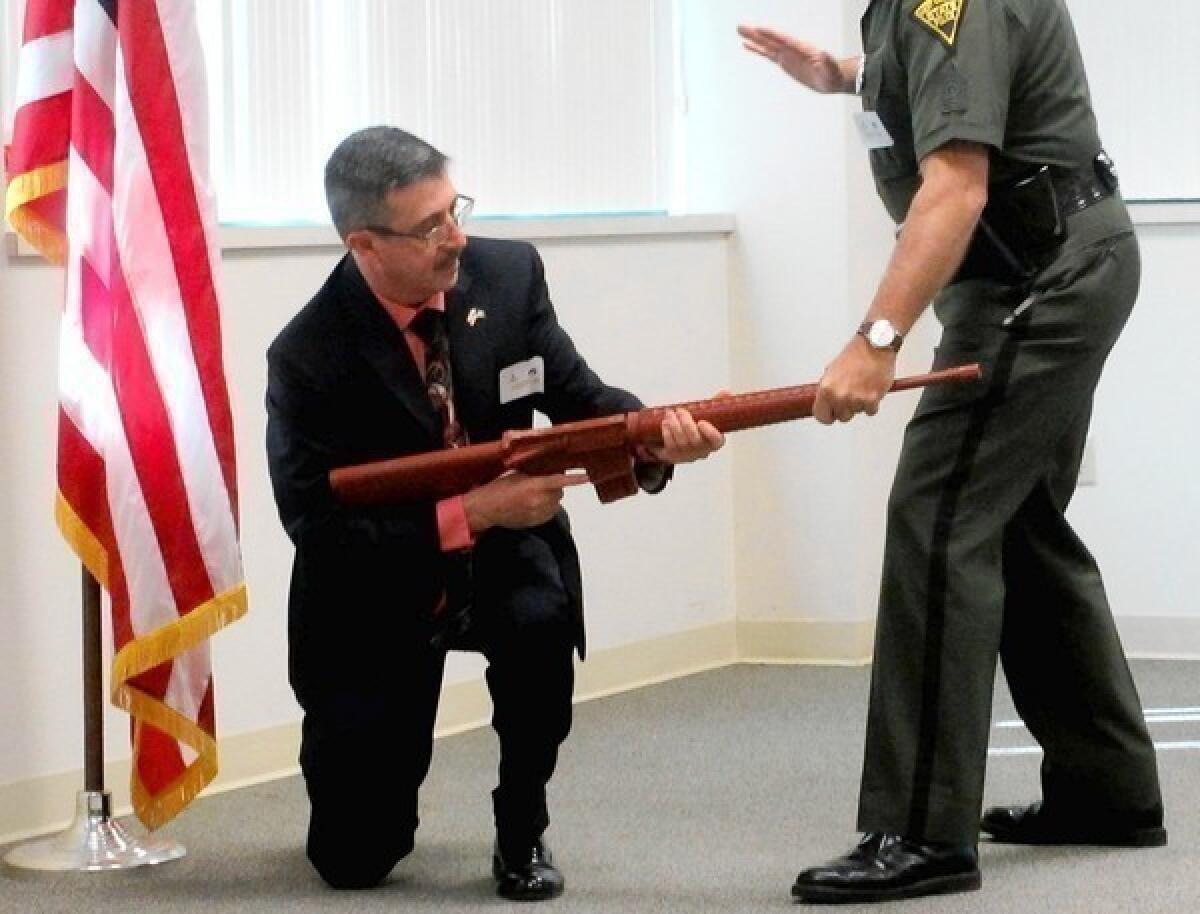Classes teach what to do if a gunman opens fire at work

CHARLESTON, W.Va. â Gunfire echoed through the building as office workers pushed a heavy table across the doorway and turned out the lights. They flattened themselves against the wall. One woman hoisted a chair high over her head. Another stood ready to hurl a juice bottle.
All eyes were on the door, the only thing separating them from a man with a gun. When he pushed his way into the room, they pounced. One woman used her hand to force the gunâs muzzle downward. A colleague kicked the back of the assailantâs knees, knocking him to the ground. Others fell upon the shooter, burying him beneath a mountain of bodies.
âNice work!â said John L. Fernatt, the âgunman,â as he scrambled to his feet and faced the crowd. They had just completed a drill in how to survive a workplace shooting.
A few years ago, office workers trapped in this situation might have been advised to crouch beneath their desks and wait for police. Now, officials faced with the grim facts of workplace violence are recommending a different tack on videos posted on company websites and in training sessions that urge employees to run, hide and, if necessary, fight.
A survivor of last monthâs Santa Monica College shooting, library assistant Jan Juliani, credited a workshop conducted by the college police with helping her stay calm and bolt for cover. But few places are taking as aggressive an approach to teaching survival techniques as West Virginia, where the state Bureau of Risk and Insurance Management offers training to government agencies and private companies.
âItâs not paranoia. Itâs awareness,â said Sgt. Michael D. Lynch of the West Virginia State Police, who has teamed up with Fernatt and Chuck S. Mozingo Jr. to deliver the sessions. âThis is for the common person who is going to be at their workplace, whoâs going to be at school, whoâs going to be out shopping.â
Lynch is the only one of the three in law enforcement, and that is part of what makes this program unusual. So is the price â itâs free â and the levity that Lynch, Fernatt and Mozingo work into their well-rehearsed presentations. Each session runs at least two hours, usually longer, and involves play-acting with fake weapons and hard-hitting lectures designed to make people to think of themselves as survivors rather than victims, even if it means using brutal means.
âBe ready to kill,â Lynch told those at a recent workshop in the state capital, Charleston.
Statistics explain the need for such courses, say Fernatt, an IT specialist at the state risk and insurance bureau, and Mozingo, an assistant claim manager there. Homicide was the fourth-leading cause of death in the workplace in 2011, the most recent year charted by the Bureau of Labor Statistics. That year, 458 people were killed at work, and firearms were used in 78% of the slayings. About 14% of office shootings end with someone other than law enforcement stopping the assailant.
âWhat weâre trying to do is increase that number,â said Fernatt.
Fernatt and Mozingo developed the idea for the course in 2008 as they sat in an airport waiting for a flight. Terminal televisions were blaring news of a workplace shooting. The pair realized that workers were prepared for a variety of on-the-job emergencies, from fires to drug-abusing colleagues. But nobody told them how to survive a mass shooting.
âIt seems like every week or so someone gets a gun into an office and starts blasting away,â said Mozingo, describing their thoughts as they sat in the airport that day. âWe thought, âWhat kind of information can we provide to people? What can we tell them?ââ
Two years later, after state police gave a thumbs-up to the course and offered to participate in presentations, they began offering the workshops.
In West Virginia, officials say there has been a steady increase in the sessionsâ popularity. Although they wonât directly attribute that to concerns arising from such massacres as last yearâs Sandy Hook Elementary School shooting in Newtown, Conn., or the attack in an Aurora, Colo., movie theater, demand has risen since those incidents. At least 14 workshops have been presented so far this year. Before this year, there had been five workshop requests. Non-state agencies that have requested classes include the YWCA.
âWe see it as a public health issue, not just a law enforcement or security issue,â said Rahul Gupta, executive director of the Kanawha-Charleston Health Department, where a March training session was filled to capacity with 110 people.
On May 30, Fernatt, Mozingo and Lynch conducted back-to-back sessions in Charleston. One took place at the West Virginia Department of Environmental Protection at the behest of Tammy Thornton, a department safety manager who for years has created drills for employees. She once sent a man with a fake hatchet into an office building after warning workers of an upcoming drill.
âThe naysayers say, âOh, itâll never happen here,ââ Thornton said. âWeâre just taking steps to make people think about what they would do if it did happen.â
Plenty of videos and Web-based courses offer advice on how to respond if someone bent on violence enters a workplace. They recommend people run, hide or, as a last resort, fight back. The Department of Homeland Security was ridiculed by some critics in January when it posted a video that showed an actor portraying an office worker reaching for scissors to try to fend off a shooter.
But Lynch says anything can be an effective weapon â a high-heeled shoe, a flowerpot.
Caryn Thornburg, who developed and teaches courses that the California Hospital Assn. has offered to workers, agrees.
âIt could be a chair. It could be a stapler,â said Thornburg, who uses a drill in which potential victims hurl tiny, lightweight balls at a âshooter.â Even though the person pretending to be a gunman knows the objects are harmless, he ducks to avoid them and is thrown off guard.
Each of Fernatt, Mozingo and Lynchâs sessions begins with a short video, âShots Fired,â which opens with a receptionist greeting a man carrying a duffel bag. âGood morning, Mark,â the receptionist says brightly. âMark?â she says in a concerned voice as he walks past her desk, grim-faced.
In seconds, the sound of pops fills the busy office.
âI canât believe this is happening,â a stunned-looking man in a tan blazer says as he stands, frozen, in a conference room. That, Lynch said, is not the way to react.
âHeâs gonna be a sheep. Heâs gonna just sit there and not escape,â Lynch said as he dissected the behavior of the actors and explained why those who are decisive and act quickly are likely to survive. As he was speaking, Fernatt suddenly appeared and pointed a plastic AR-15 semiautomatic rifle at his chest. Lynch used one hand to point the muzzle toward the floor.
âIt doesnât take brute force,â he said as he invited volunteers from the largely female class to try it.
Mozingo said the most common feedback he gets is that the course should be required. Some people also say it should run longer.
âThatâs one of the most gratifying comments I get,â said Mozingo. âWho ever asks for longer training?â
More to Read
Sign up for Essential California
The most important California stories and recommendations in your inbox every morning.
You may occasionally receive promotional content from the Los Angeles Times.











